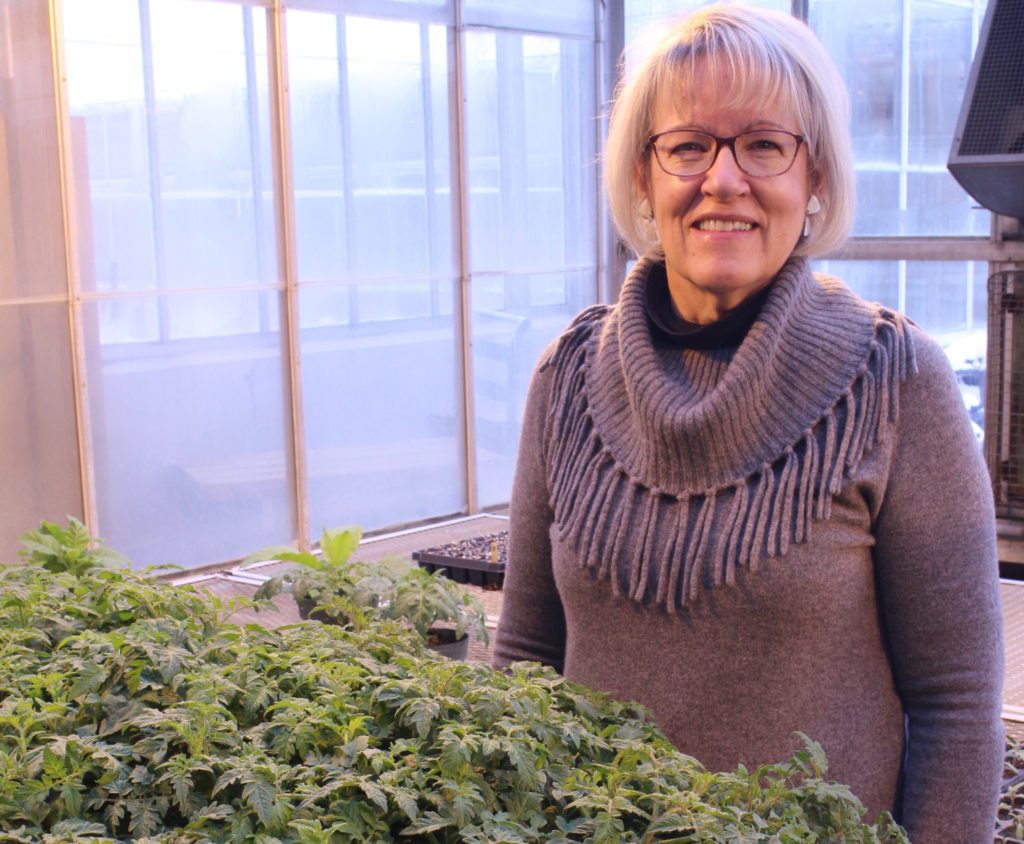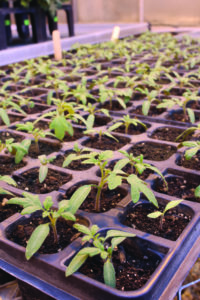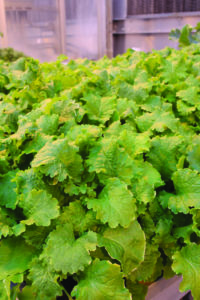

Aug 7, 2018Sanitation, seed choice help control hydroponics pathogens
Tomatoes are one of the most popular vegetables to be grown in hydroponic greenhouses, but face different diseases than tomatoes grown in the open field.
For hydroponic tomatoes, bacterial canker can be the worst. “The most insidious part of these bacteria is that you never see them,” said Sally Miller, professor in vegetable pathology at Ohio State University’s Ohio Agricultural and Research Development Center (OARDC) at Wooster, Ohio.
The bacteria germinate, translocate in the plant and aren’t visible until the damage shows up – 10 days to two weeks after infection, depending on the variety.
“Canker is systemic,” Miller said. “The bacteria move up in the plant and move straight down into the roots. In a hydroponic environment, the roots are sloughing off bacteria all of the time and spreading the infection.”
Miller was a speaker on vegetable diseases at a recent Hydroponic Greenhouse Workshop at the OARDC.
Growers entering hydroponic vegetable production will need to learn about diseases they may not have seen before.
“There is a big difference, as far as diseases and their causes, in what you see outside in the field and what you see inside the greenhouse,” Miller said.
Outside, the challenges are rain-splashed diseases like septoria and bacterial spot. In greenhouses, it’s diseases that prefer high humidity.
Botrytis grey mold occurs in cool, damp conditions. “Botrytis is a high humidity problem,” Miller said. It’s favored by dense foliage and poor air circulation and is common in greenhouses and high tunnels.
Fulvia leaf mold is also favored by cool temperatures and high relative humidity. Fulvia sporulates on the underside of the leaf and can be easily confused with late blight.
Powdery mildew is one of the worst fungi in greenhouses. It favors moderate temperatures and high humidity, especially at night.
Tomato late blight can occur under cool, moist conditions. It is more common in autumn in high tunnels but can occur anytime. If uncontrolled, it can destroy plants in days. “It is a really devastating disease and it can happen quickly,” Miller said. “Proper environmental management inside a greenhouse is vital.”
Crazy root is an emerging disease of tomatoes and cucumbers in hydroponics. “This is a new one,” Miller said. “It’s where the plant puts all of its energy into growing roots and not fruit.” Crazy root is also called root mat or hairy root.
Crazy root is more of a problem in rockwool than in other media. “Most bacteria get into plant roots through an injury,” Miller said. “The rockwool system has more root injury as the roots rub in the substrate.”
Hydroponic growers should also be aware of the diseases caused by viruses.
They include the tospoviruses like tomato spotted wild virus, which are transmitted by thrips, and the viruses like pepino mosaic virus and tobacco mosaic virus. Some of these diseases are seedborne or can be transmitted by mechanical injury.
Viroids also causes diseases. These include tomato chlorotic dwarf viroid, Mexican pepita viroid, tomato planta macho viroid and potato spindle tuber viroid and can also be seedborne or mechanically transmitted.
Some pathogens, like leaf mold, have a narrow host range and only attack a particular plant species or variety. Other pathogens, like bacterial canker and late blight, have a moderate host range and attack one or more species within a plant family. Some pathogens, like botrytis, have a broad host range and attack multiple plant families.
“You may not worry about plants outside the greenhouse, but there might be a plant grown outside that could be a source of pathogen inoculum,” Miller said. “Some of these pathogens have a broad host range.”
Scouting and diagnosis starts with knowing the symptoms of the pathogen. “You really need to understand the basic epidemiological characteristics of the pathogen,” Miller said. “Scouting is important, but we don’t see the spores and we may not see the insect vectors flying around.”
The diagnosis should be confirmed by testing. “There are diagnostic kits available, but you have to have an idea of what the problem is,” Miller said. “The kits don’t tell you what to do. You have to have an idea about what to test for.”
Most agricultural universities and some commercial labs offer diagnostic testing services. Make sure you follow the lab’s protocol for submitting samples. Poorly collected, poorly packaged or poorly shipped samples may not produce an accurate test. Many types of samples must be shipped with next-day delivery.


Pathogens can be introduced and transmitted by seed, water, soil, plant debris, air, insect vectors or direct contact. Direct contact is by contaminated hands, clothing, tools and plant or plant propagation. “A big problem is intercropping where growers start another crop before closing out the old one and breaking the cycle,” Miller said.
Some of the most important seedborne diseases are tomato bacterial canker, lettuce mosaic virus, pepper mild mottle virus, tomato mosaic virus and tobacco mosaic virus.
Seed producers test their seed for known, important pathogens, but test by sample and some pathogens may escape detection. “Pathogens present in or on even a few contaminated seeds can spread rapidly,” Miller said.
Some crops aren’t affected by a seed-borne pathogen, but serve as a source of inoculum. “Bacterial canker isn’t systemic in peppers, it doesn’t move up and down the vascular system, but infested seed can be a source of inoculum to infect tomatoes,” Miller said.
Seed can be sanitized to remove pathogens, but the treatment may reduce vigor and conflict with priming and pelleting. “It’s really hard to sanitize pelleted or pesticide-treated seed,” Miller said. “The pelleting material and pesticides are washed off by the sanitizer solution.”
Properly used, a hot water treatment kills most plant disease-causing bacteria on and within seeds. Growers should only use a hot water, seed treatment on raw seed, and primed seed should not be treated.
The treatment is suggested for eggplant, pepper, tomato, carrot, spinach, lettuce, celery, cabbage, turnip, radish and seeds of the other crucifers. The seeds of cucurbits, such as squash, gourds, pumpkins, or watermelons, may be damaged by hot water. It is highly recommended to treat a small sample and test it for germination prior to treating the entire seed lot.
Maintaining water temperatures within one degree Fahrenheit of the recommended treatment temperature is critical to prevent seed damage and ensure the pathogens are completely eliminated.
Brussels sprouts, eggplant, spinach, cabbage and tomato seed should be treated for 25 minutes in a water temperature of 122 degrees Fahrenheit. Treat broccoli, cauliflower, carrot, collard, kale, kohlrabi, rutabaga, turnip and cucumber at 122 degrees for 20 minutes and mustard, cress and radish 122 degrees for 15 minutes.
Pepper should be treated at 125 degrees for 30 minutes. Treat lettuce, celery and celeriac at 118 degrees for 30 minutes.
A seed treatment with bleach, as either a stand-alone treatment, or following the hot treatment is another option.
Tomato growers should consider purchasing seeds or transplants from GSPP-certified producers (www.gspp. eu). GSPP is the Good Seed and Plant Practices system designed in Europe primarily to prevent bacterial canker, although these practices can also prevent other diseases. Accredited producers must adhere to strict guidelines to prevent bacterial canker from entering the seed or seedling production chain.
Even with seed treatment, the other avenues of inoculum entry into the greenhouse must be addressed.
Pathogens such as fungal spores can be blown into greenhouses on air currents. Be sure to keep cull piles and inoculum sources away from intake vents.
Water can move pathogens into and around in the greenhouse. Using well water or municipal water as the water source is better than using surface water which is more exposed to the environment and may harbor plant pathogens.
Not using overhead irrigation and sanitizing recirculated water are also good practices. “There are sophisticated systems that treat recirculated water with UV light or other sanitizers,” Miller said.
Pathogens can be brought into the greenhouse on soil and plant debris. Eliminate nearby cull piles and remove any debris from the greenhouse. “These sources of inoculum should be removed right away,” Miller said.
Keeping relative humidity low inside the greenhouse is a critical management strategy. You also want to maintain air movement to dry foliage and avoid abrupt changes in temperature that might case condensation.
Wash all surfaces in the greenhouse and follow up with a sanitizer treatment. “Many sanitizers become deactivated when they come in contact with organic material,” Miller said.
Growers should also clean clothing and equipment, use foot baths with active disinfectant and limit visitor access to the greenhouses.


Genetic resistance for certain diseases has been bred into many varieties, but no varieties are resistant to all diseases. Varieties described as tolerant are only partially resistant.
Grafting is common in tomatoes and some cucurbits to add disease resistance and improve vigor.
Shears can be effectively disinfected with tools that automatically deliver disinfectant with each action of the trimming tools. Examples of systems with automated delivery are the Menno Knife and Felco Shears. This prevents clipping from spreading disease like canker from plant to plant.
There are also biologicals and fungicides that can be used in the greenhouse. “Biologicals aren’t going to be a knock-down treatment,” Miller said. “They’re going to be more for managing thresholds.”
There are fungicides that are effective on greenhouse diseases, but the label restrictions for using a product in a greenhouse are probably different than what’s labeled for field use.
Preharvest intervals and re-entry intervals are key numbers as well as calibration. Greenhouse use rates may not be on the label and you’ll have to convert gallons per acre to ounces per square foot.
Chemical labels will either say a product’s use in a greenhouse is allowed or prohibited or the label will be silent and not say anything about greenhouse use. “If the label is silent, the Ohio Department of Agriculture says you can use the product in Ohio,” Miller said. You’ll need to check with the department of agriculture in your state.
– Dean Peterson, VGN Correspondent














